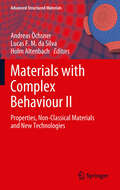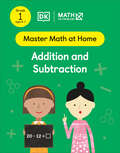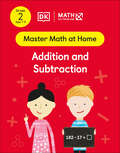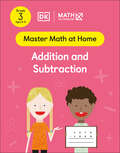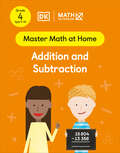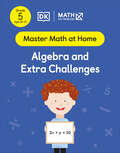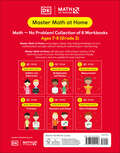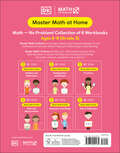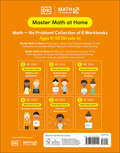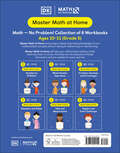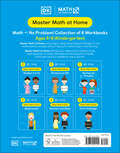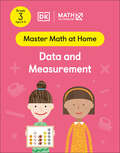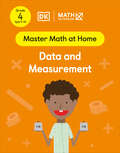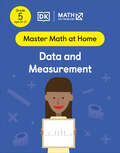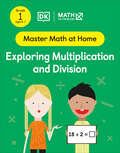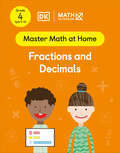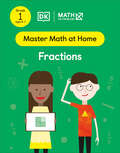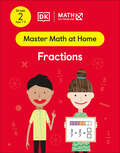- Table View
- List View
Materials with Complex Behaviour II: Properties, Non-Classical Materials and New Technologies
by Andreas Öchsner Lucas F. Silva Holm AltenbachThis volume highlights the latest developments and trends in advanced materials and their properties, the modeling and simulation of non-classical materials and structures, and new technologies for joining materials. It presents the developments of advanced materials and respective tools to characterize and predict the material properties and behavior.
Math - No Problem! Addition and Subtraction, Grade 1 Ages 6-7 (Master Math at Home)
by Math - No Problem!A colorful workbook to help children learn addition and subtraction using the Math Mastery approach!It&’s time to master the world of math with this brand new workbook developed by experts to cover all the essential skills for children in the first stages of their math journey. Specifically designed for children aged 6-7, this math exercise book can gently help your child develop a knowledge of simple adding and subtracting, using a range of different methods.Let Math — No Problem! open your eyes to the wonderful world of numbers! So what are you waiting for? Dive straight in to discover: Topics include adding and subtracting one- and two-digit numbers using columns and renamingCharacter-led learning with fun and friendly illustrationsComprehensive and thorough coverage of key conceptsHelpful hints for extra practiceHeard of Math Mastery but don&’t know where to begin? Don&’t worry, DK has got you covered!Math Mastery is a transformational approach to teaching mathematics that was developed in Singapore and is now used around the world, including in thousands of schools across the US.Children are taught multiple methods to solve math problems, enabling them to gain a thorough and adaptable understanding of topics, making it easier for them to apply their knowledge to different scenarios. Each topic is studied in depth to develop a secure understanding of math concepts. This leads to greater progress in math learning, as topics are well understood and therefore don&’t need to be revised in great detail, meaning each new concept builds on prior learning. Based on this widely successful approach, this wonderful workbook is full of top tips led by appealing characters who offer useful guidance to parents and children alike with the goal of making learning math both accessible and interesting. This workbook is part of a new series developed in partnership with the award-winning educational publisher Math — No Problem! The books encourage a deep knowledge of core math concepts without fostering a reliance on memorization or rote learning. A must-have math book for children aged 6-7 at a Grade 1 level, as well as for adults who wish to become more familiar with math taught in schools, to better support their children at home.From simple subtraction to self-check quizzes, this helpful workbook covers it all while incorporating an inclusive approach which builds self-confidence so that no child feels they &‘can&’t do math&’.At DK, we believe in the power of discovery. So why not explore the rest of the workbooks in our Math — No Problem! Master Math At Home series? Each workbook can be bought individually or as part of a collection, specifically targeted to early learners aged 6-7 at a Grade 1 level. Multiply like a magician with Math — No Problem! Exploring Multiplication and Division, Grade 1 Ages 6-7 or join the geometry fun with Math — No Problem! Geometry and Shape, Grade 1 Ages 6-7.It&’s as easy as 1, 2, 3!
Math - No Problem! Addition and Subtraction, Grade 2 Ages 7-8 (Master Math at Home)
by Math - No Problem!A colorful workbook to help children learn addition and subtraction using the Math Mastery approach!It&’s time to master the world of math with this brand new workbook developed by experts to cover all the essential skills for children in the first stages of their math journey. Specifically designed for children aged 7-8, this math exercise book can gently help your child develop a knowledge of different methods for addition and subtraction.Let Math — No Problem! open your eyes to the wonderful world of numbers! So what are you waiting for? Dive straight in to discover: - Topics include adding and subtracting with and without renaming, place value, and adding three or four 2-digit numbers.- Character-led learning with fun and friendly illustrations.- Comprehensive and thorough coverage of key concepts.- Helpful hints for extra practice.Heard of Math Mastery but don&’t know where to begin? Don&’t worry, DK has got you covered!Math Mastery is a transformational approach to teaching mathematics that was developed in Singapore and is now used around the world, including in thousands of schools across the US.Children are taught multiple methods to solve math problems, enabling them to gain a thorough and adaptable understanding of topics, making it easier for them to apply their knowledge to different scenarios. Each topic is studied in depth to develop a secure understanding of math concepts. This leads to greater progress in math learning, as topics are well understood and therefore don&’t need to be revised in great detail, meaning each new concept builds on prior learning. Based on this widely successful approach, this wonderful workbook is full of top tips led by appealing characters who offer useful guidance to parents and children alike with the goal of making learning math both accessible and interesting. This workbook is part of a new series developed in partnership with the award-winning educational publisher Math — No Problem! The books encourage a deep knowledge of core math concepts without fostering a reliance on memorization or rote learning. A must-have math book for children aged 7-8 at a Grade 2 level, as well as for adults who wish to become more familiar with math taught in schools, to better support their children at home.From subtraction to self-check quizzes, this helpful workbook covers it all while incorporating an inclusive approach which builds self-confidence so that no child feels they &‘can&’t do math&’.At DK, we believe in the power of discovery. So why not explore the rest of the workbooks in our Math — No Problem! Master Math At Home series? Each workbook can be bought individually or as part of a collection, specifically targeted to early learners aged 7-8 at a Grade 2 level. Multiply like a magician with Math — No Problem! Multiplication and Division, Grade 2 ages 7-8 and join the geometry fun with Math — No Problem! Geometry and Shape, Grade 2 Ages 7-8.It&’s as easy as 1, 2, 3!
Math - No Problem! Addition and Subtraction, Grade 3 Ages 8-9 (Master Math at Home)
by Math - No Problem!A colorful workbook to help children learn addition and subtraction using the Math Mastery approach!It&’s time to master the world of math with this brand new workbook developed by experts to cover all the essential skills for children in the first stages of their math journey. Specifically designed for children aged 8-9, this math exercise book can gently help your child develop knowledge of addition and subtraction and comparing 4-digit numbers, using a range of different methods.Let Math — No Problem! open your eyes to the wonderful world of numbers! So what are you waiting for? Dive straight in to discover: - Topics include different methods of adding and subtraction 3-digit and 4-digit numbers, number patterns, rounding numbers, comparing and ordering numbers.- Character-led learning with fun and friendly illustrations.- Comprehensive and thorough coverage of key concepts.- Helpful hints for extra practice.Heard of Math Mastery but don&’t know where to begin? Don&’t worry, DK has got you covered!Math Mastery is a transformational approach to teaching mathematics that was developed in Singapore and is now used around the world, including in thousands of schools across the US.Children are taught multiple methods to solve math problems, enabling them to gain a thorough and adaptable understanding of topics, making it easier for them to apply their knowledge to different scenarios. Each topic is studied in depth to develop a secure understanding of math concepts. This leads to greater progress in math learning, as topics are well understood and therefore don&’t need to be revised in great detail, meaning each new concept builds on prior learning. Based on this widely successful approach, this wonderful workbook is full of top tips led by appealing characters who offer useful guidance to parents and children alike with the goal of making learning math both accessible and interesting. This workbook is part of a new series developed in partnership with the award-winning educational publisher Math — No Problem! The books encourage a deep knowledge of core math concepts without fostering a reliance on memorization or rote learning. A must-have math book for children aged 8-9 at a Grade 3 level, as well as for adults who wish to become more familiar with math taught in schools, to better support their children at home.From finding sums to solving word problems, this helpful workbook covers it all while incorporating an inclusive approach which builds self-confidence so that no child feels they &‘can&’t do math&’.At DK, we believe in the power of discovery. So why not explore the rest of the workbooks in our Math — No Problem! Master Math At Home series? Each workbook can be bought individually or as part of a collection, specifically targeted to early learners aged 8-9 at a Grade 3 level. Multiply like a magician with Math — No Problem! Multiplication and Division, Grade 3 Ages 8-9 or join the geometry journey with Math — No Problem! Geometry and Shape, Grade 3 Ages 8-9.It&’s as easy as 1, 2, 3!
Math - No Problem! Addition and Subtraction, Grade 4 Ages 9-10 (Master Math at Home)
by Math - No Problem!A colorful workbook to help children learn addition and subtraction using the Math Mastery approach!It&’s time to master the world of math with this brand new workbook developed by experts to cover all the essential skills for children in the first stages of their math journey. Specifically designed for children aged 9-10, this math exercise book can gently help your child develop knowledge of different methods for addition and subtraction up to 1,000,000. Let Math — No Problem! open your eyes to the wonderful world of numbers! So what are you waiting for? Dive straight in to discover: - Topics include numbers up to 1,000,000, and different mental strategies for addition and subtraction.- Character-led learning with fun and friendly illustrations.- Comprehensive and thorough coverage of key concepts.- Helpful hints for extra practice.Heard of Math Mastery but don&’t know where to begin? Don&’t worry, DK has got you covered!Math Mastery is a transformational approach to teaching mathematics that was developed in Singapore and is now used around the world, including in thousands of schools across the US.Children are taught multiple methods to solve math problems, enabling them to gain a thorough and adaptable understanding of topics, making it easier for them to apply their knowledge to different scenarios. Each topic is studied in depth to develop a secure understanding of math concepts. This leads to greater progress in math learning, as topics are well understood and therefore don&’t need to be revised in great detail, meaning each new concept builds on prior learning. Based on this widely successful approach, this wonderful workbook is full of top tips led by appealing characters who offer useful guidance to parents and children alike with the goal of making learning math both accessible and interesting. This workbook is part of a new series developed in partnership with the award-winning educational publisher Math — No Problem! The books encourage a deep knowledge of core math concepts without fostering a reliance on memorization or rote learning. A must-have math book for children aged 9-10 at a Grade 4 level, as well as for adults who wish to become more familiar with math taught in schools, to better support their children at home.From finding sums to solving world problems, this helpful workbook covers it all while incorporating an inclusive approach which builds self-confidence so that no child feels they &‘can&’t do math&’.At DK, we believe in the power of discovery. So why not explore the rest of the workbooks in our Math — No Problem! Master Math At Home series? Each workbook can be bought individually or as part of a collection, specifically targeted to early learners aged 9-10 at a Grade 4 level. Multiply like a magician with Math — No Problem! Multiplication and Division, Grade 4 Ages 9-10 or join the geometry journey with Math — No Problem! Geometry and Shape, Grade 4 Ages 9-10.It&’s as easy as 1, 2, 3!
Math - No Problem! Algebra and Extra Challenges, Grade 5 Ages 10-11 (Master Math at Home)
by Math - No Problem!A colorful workbook to help children learn addition and subtraction using the Math Mastery approach!It&’s time to master the world of math with this brand new workbook developed by experts to cover all the essential skills for children in the first stages of their math journey. Specifically designed for children aged 10-11, this math exercise book can gently help your child develop knowledge of engaging number activities, word problems and mathematical investigations, using a range of different methods.Let Math — No Problem! open your eyes to the wonderful world of numbers! So what are you waiting for? Dive straight in to discover: - Topics include mental math problem-solving. further practice of math skills, and algebra- Character-led learning with fun and friendly illustrations- Comprehensive and thorough coverage of key concepts- Helpful hints for extra practice.Heard of Math Mastery but don&’t know where to begin? Don&’t worry, DK has got you covered!Math Mastery is a transformational approach to teaching mathematics that was developed in Singapore and is now used around the world, including in thousands of schools across the US.Children are taught multiple methods to solve math problems, enabling them to gain a thorough and adaptable understanding of topics, making it easier for them to apply their knowledge to different scenarios. Each topic is studied in depth to develop a secure understanding of math concepts. This leads to greater progress in math learning, as topics are well understood and therefore don&’t need to be revised in great detail, meaning each new concept builds on prior learning. Based on this widely successful approach, this wonderful workbook is full of top tips led by appealing characters who offer useful guidance to parents and children alike with the goal of making learning math both accessible and interesting. This workbook is part of a new series developed in partnership with the award-winning educational publisher Math — No Problem! The books encourage a deep knowledge of core math concepts without fostering a reliance on memorization or rote learning. A must-have math book for children aged 10-11 at a Grade 5 level, as well as for adults who wish to become more familiar with math taught in schools, to better support their children at home.From self-assessment quizzes to mental math problems, this helpful workbook covers it all while incorporating an inclusive approach which builds self-confidence so that no child feels they &‘can&’t do math&’.At DK, we believe in the power of discovery. So why not explore the rest of the workbooks in our Math — No Problem! Master Math At Home series? Each workbook can be bought individually or as part of a collection, specifically targeted to early learners aged 10-11 at a Grade 5 level. Know your numbers like a pro with Math — No Problem! Numbers to 10 Million, Grade 5 Ages 10-11 or join the geometry journey with Math — No Problem! Geometry and Shape, Grade 5 Ages 10-11.It&’s as easy as 1, 2, 3!
Math - No Problem! Collection of 6 Workbooks, Grade 1 Ages 6-7 (Master Math at Home)
by Math - No Problem!A colorful workbook to help children learn addition and subtraction using the Math Mastery approach!It&’s time to master the world of math with this brand new workbook developed by experts to cover all the essential skills for children in the first stages of their math journey. Specifically designed for children aged 6-7, this math exercise book can gently help your child develop a knowledge of multiplication and division, fractions and more using a range of different methods.Let Math — No Problem! open your eyes to the wonderful world of numbers! So what are you waiting for? Dive straight in to discover: Topics include addition and subtraction, multiplication and division, fractions, shapes and measuringCharacter-led learning with fun and friendly illustrationsComprehensive and thorough coverage of key conceptsHelpful hints for extra practiceHeard of Math Mastery but don&’t know where to begin? Don&’t worry, DK has got you covered!Math Mastery is a transformational approach to teaching mathematics that was developed in Singapore and is now used around the world, including in thousands of schools across the US.Children are taught multiple methods to solve math problems, enabling them to gain a thorough and adaptable understanding of topics, making it easier for them to apply their knowledge to different scenarios. Each topic is studied in depth to develop a secure understanding of math concepts. This leads to greater progress in math learning, as topics are well understood and therefore don&’t need to be revised in great detail, meaning each new concept builds on prior learning. Based on this widely successful approach, this wonderful workbook is full of top tips led by appealing characters who offer useful guidance to parents and children alike with the goal of making learning math both accessible and interesting. This workbook is part of a new series developed in partnership with the award-winning educational publisher Math — No Problem! The books encourage a deep knowledge of core math concepts without fostering a reliance on memorization or rote learning. A must-have math book for children aged 6-7 at a Grade 1 level, as well as for adults who wish to become more familiar with math taught in schools, to better support their children at home.From telling the time to finding fractions, this helpful workbook covers it all while incorporating an inclusive approach which builds self-confidence so that no child feels they &‘can&’t do math&’.At DK, we believe in the power of discovery. So why not explore the rest of the workbooks in our Math — No Problem! Master Math At Home series? Each workbook can be bought individually or as part of a collection, specifically targeted to early learners aged 6-7 at a Grade 1 level. Multiply like a magician with Math — No Problem! Exploring Multiplication and Division, Grade 1 Ages 6-7 or join the geometry fun with Math — No Problem! Geometry and Shape, Grade 1 Ages 6-7.It&’s as easy as 1, 2, 3!
Math - No Problem! Collection of 6 Workbooks, Grade 2 Ages 7-8 (Master Math at Home)
by Math - No Problem!A colorful workbook to help children learn addition and subtraction using the Math Mastery approach!It&’s time to master the world of math with this brand new workbook developed by experts to cover all the essential skills for children in the first stages of their math journey. Specifically designed for children aged 7-8, this math exercise book can gently help your child develop a knowledge of measuring and time, shapes, fractions, multiplication and more, using a range of different methods.Let Math — No Problem! open your eyes to the wonderful world of numbers! So what are you waiting for? Dive straight in to discover: - Topics include addition and subtraction, shapes, measuring, fractions, multiplication and division, and extra challenges.- Character-led learning with fun and friendly illustrations.- Comprehensive and thorough coverage of key concepts.- Helpful hints for extra practice.Heard of Math Mastery but don&’t know where to begin? Don&’t worry, DK has got you covered!Math Mastery is a transformational approach to teaching mathematics that was developed in Singapore and is now used around the world, including in thousands of schools across the US.Children are taught multiple methods to solve math problems, enabling them to gain a thorough and adaptable understanding of topics, making it easier for them to apply their knowledge to different scenarios. Each topic is studied in depth to develop a secure understanding of math concepts. This leads to greater progress in math learning, as topics are well understood and therefore don&’t need to be revised in great detail, meaning each new concept builds on prior learning. Based on this widely successful approach, this wonderful workbook is full of top tips led by appealing characters who offer useful guidance to parents and children alike with the goal of making learning math both accessible and interesting. This workbook is part of a new series developed in partnership with the award-winning educational publisher Math — No Problem! The books encourage a deep knowledge of core math concepts without fostering a reliance on memorization or rote learning. A must-have math book for children aged 7-8 at a Grade 2 level, as well as for adults who wish to become more familiar with math taught in schools, to better support their children at home.From measuring to multiplication, this helpful workbook covers it all while incorporating an inclusive approach which builds self-confidence so that no child feels they &‘can&’t do math&’.At DK, we believe in the power of discovery. So why not explore the rest of the workbooks in our Math — No Problem! Master Math At Home series? Each workbook can be bought individually or as part of a collection, specifically targeted to early learners aged 7-8 at a Grade 2 level. Multiply like a magician with Math — No Problem! Multiplication and Division, Grade 2 ages 7-8 and join the geometry fun with Math — No Problem! Geometry and Shape, Grade 2 Ages 7-8.It&’s as easy as 1, 2, 3!
Math - No Problem! Collection of 6 Workbooks, Grade 3 Ages 8-9 (Master Math at Home)
by Math - No Problem!A colorful workbook to help children learn addition and subtraction using the Math Mastery approach!It&’s time to master the world of math with this brand new workbook developed by experts to cover all the essential skills for children in the first stages of their math journey. Specifically designed for children aged 8-9, this math exercise book can gently help your child develop knowledge of geometry, shapes, measuring and more, using a range of different methods.Let Math — No Problem! open your eyes to the wonderful world of numbers! So what are you waiting for? Dive straight in to discover: - Topics include addition and subtraction, multiplication and division, fractions, decimals, measuring, extra challenges, and math investigations.- Character-led learning with fun and friendly illustrations.- Comprehensive and thorough coverage of key concepts.- Helpful hints for extra practice.Heard of Math Mastery but don&’t know where to begin? Don&’t worry, DK has got you covered!Math Mastery is a transformational approach to teaching mathematics that was developed in Singapore and is now used around the world, including in thousands of schools across the US.Children are taught multiple methods to solve math problems, enabling them to gain a thorough and adaptable understanding of topics, making it easier for them to apply their knowledge to different scenarios. Each topic is studied in depth to develop a secure understanding of math concepts. This leads to greater progress in math learning, as topics are well understood and therefore don&’t need to be revised in great detail, meaning each new concept builds on prior learning. Based on this widely successful approach, this wonderful workbook is full of top tips led by appealing characters who offer useful guidance to parents and children alike with the goal of making learning math both accessible and interesting. This workbook is part of a new series developed in partnership with the award-winning educational publisher Math — No Problem! The books encourage a deep knowledge of core math concepts without fostering a reliance on memorization or rote learning. A must-have math book for children aged 8-9 at a Grade 3 level, as well as for adults who wish to become more familiar with math taught in schools, to better support their children at home.From telling the time to times tables, subtraction to self-check quizzes, this helpful workbook covers it all while incorporating an inclusive approach which builds self-confidence so that no child feels they &‘can&’t do math&’.At DK, we believe in the power of discovery. So why not explore the rest of the workbooks in our Math — No Problem! Master Math At Home series? Each workbook can be bought individually or as part of a collection, specifically targeted to early learners aged 8-9 at a Grade 3 level. Multiply like a magician with Math — No Problem! Multiplication and Division, Grade 3 Ages 8-9 or join the geometry journey with Math — No Problem! Geometry and Shape, Grade 3 Ages 8-9.It&’s as easy as 1, 2, 3!
Math - No Problem! Collection of 6 Workbooks, Grade 4 Ages 9-10 (Master Math at Home)
by Math - No Problem!A colorful workbook to help children learn addition and subtraction using the Math Mastery approach!It&’s time to master the world of math with this brand new workbook developed by experts to cover all the essential skills for children in the first stages of their math journey. Specifically designed for children aged 9-10, this math exercise book can gently help your child develop knowledge of shapes, fractions, decimals, measuring data and more, using a range of different methods.Let Math — No Problem! open your eyes to the wonderful world of numbers! So what are you waiting for? Dive straight in to discover: - Topics include addition and subtraction, maths Investigations, measuring, fractions and decimals, multiplication and division, and extra challenges.- Character-led learning with fun and friendly illustrations.- Comprehensive and thorough coverage of key concepts.- Helpful hints for extra practice.Heard of Math Mastery but don&’t know where to begin? Don&’t worry, DK has got you covered!Math Mastery is a transformational approach to teaching mathematics that was developed in Singapore and is now used around the world, including in thousands of schools across the US.Children are taught multiple methods to solve math problems, enabling them to gain a thorough and adaptable understanding of topics, making it easier for them to apply their knowledge to different scenarios. Each topic is studied in depth to develop a secure understanding of math concepts. This leads to greater progress in math learning, as topics are well understood and therefore don&’t need to be revised in great detail, meaning each new concept builds on prior learning. Based on this widely successful approach, this wonderful workbook is full of top tips led by appealing characters who offer useful guidance to parents and children alike with the goal of making learning math both accessible and interesting. This workbook is part of a new series developed in partnership with the award-winning educational publisher Math — No Problem! The books encourage a deep knowledge of core math concepts without fostering a reliance on memorization or rote learning. A must-have math book for children aged 9-10 at a Grade 4 level, as well as for adults who wish to become more familiar with math taught in schools, to better support their children at home.From comparing decimals to cube numbers, this helpful workbook covers it all while incorporating an inclusive approach which builds self-confidence so that no child feels they &‘can&’t do math&’.At DK, we believe in the power of discovery. So why not explore the rest of the workbooks in our Math — No Problem! Master Math At Home series? Each workbook can be bought individually or as part of a collection, specifically targeted to early learners aged 9-10 at a Grade 4 level. Multiply like a magician with Math — No Problem! Multiplication and Division, Grade 4 Ages 9-10 or join the geometry journey with Math — No Problem! Geometry and Shape, Grade 4 Ages 9-10.It&’s as easy as 1, 2, 3!
Math - No Problem! Collection of 6 Workbooks, Grade 5 Ages 10-11 (Master Math at Home)
by Math - No Problem!A colorful workbook to help children learn addition and subtraction using the Math Mastery approach!It&’s time to master the world of math with this brand new workbook developed by experts to cover all the essential skills for children in the first stages of their math journey. Specifically designed for children aged 10-11, this math exercise book can gently help your child develop knowledge of fractions, decimals, data measuring and so much more, using a range of different methods.Let Math — No Problem! open your eyes to the wonderful world of numbers! So what are you waiting for? Dive straight in to discover: - Topics include addition and subtraction, measuring, fractions, decimals and percentages, shapes, multiplication and division, and extra challenges.- Character-led learning with fun and friendly illustrations.- Comprehensive and thorough coverage of key concepts.- Helpful hints for extra practice.Heard of Math Mastery but don&’t know where to begin? Don&’t worry, DK has got you covered!Math Mastery is a transformational approach to teaching mathematics that was developed in Singapore and is now used around the world, including in thousands of schools across the US.Children are taught multiple methods to solve math problems, enabling them to gain a thorough and adaptable understanding of topics, making it easier for them to apply their knowledge to different scenarios. Each topic is studied in depth to develop a secure understanding of math concepts. This leads to greater progress in math learning, as topics are well understood and therefore don&’t need to be revised in great detail, meaning each new concept builds on prior learning. Based on this widely successful approach, this wonderful workbook is full of top tips led by appealing characters who offer useful guidance to parents and children alike with the goal of making learning math both accessible and interesting. This workbook is part of a new series developed in partnership with the award-winning educational publisher Math — No Problem! The books encourage a deep knowledge of core math concepts without fostering a reliance on memorization or rote learning.A must-have math book for children aged 10-11 at a Grade 5 level, as well as for adults who wish to become more familiar with math taught in schools, to better support their children at home.From division to decimals, this helpful workbook covers it all while incorporating an inclusive approach which builds self-confidence so that no child feels they &‘can&’t do math&’.At DK, we believe in the power of discovery. So why not explore the rest of the workbooks in our Math — No Problem! Master Math At Home series? Each workbook can be bought individually or as part of a collection, specifically targeted to early learners aged 10-11 at a Grade 5 level. Know your numbers like a pro with Math — No Problem! Numbers to 10 Million, Grade 5 Ages 10-11 or join the geometry journey with Math — No Problem! Geometry and Shape, Grade 5 Ages 10-11.It&’s as easy as 1, 2, 3!
Math - No Problem! Collection of 6 Workbooks, Kindergarten Ages 5-6 (Master Math at Home)
by Math - No Problem!A colorful workbook to help children learn addition and subtraction using the Math Mastery approach!It&’s time to master the world of math with this brand new workbook developed by experts to cover all the essential skills for children in the first stages of their math journey. Specifically designed for children aged 5-6, this math exercise book can gently help your child develop knowledge of simple counting, grouping, measuring and more using a range of different methods.Let Math — No Problem! open your eyes to the wonderful world of numbers! So what are you waiting for? Dive straight in to discover: - Topics include numbers, counting, addition and subtraction, shapes, sharing and grouping, measuring and extra challenges.- Character-led learning with fun and friendly illustrations- Comprehensive and thorough coverage of key concepts- Helpful hints for extra practiceHeard of Math Mastery but don&’t know where to begin? Don&’t worry, DK has got you covered!Math Mastery is a transformational approach to teaching mathematics that was developed in Singapore and is now used around the world, including in thousands of schools across the US.Children are taught multiple methods to solve math problems, enabling them to gain a thorough and adaptable understanding of topics, making it easier for them to apply their knowledge to different scenarios. Each topic is studied in depth to develop a secure understanding of math concepts. This leads to greater progress in math learning, as topics are well understood and therefore don&’t need to be revised in great detail, meaning each new concept builds on prior learning. Based on this widely successful approach, this wonderful workbook is full of top tips led by appealing characters who offer useful guidance to parents and children alike with the goal of making learning math both accessible and interesting. This workbook is part of a new series developed in partnership with the award-winning educational publisher Math — No Problem! The books encourage a deep knowledge of core math concepts without fostering a reliance on memorization or rote learning.A must-have math book for children aged 5-6 at a Kindergarten level, as well as for adults who wish to become more familiar with math taught in schools, to better support their children at home.From subtraction to sequencing, this helpful workbook covers it all while incorporating an inclusive approach which builds self-confidence so that no child feels they &‘can&’t do math&’.At DK, we believe in the power of discovery. So why not explore the rest of the workbooks in our Math — No Problem! Master Math At Home series? Each workbook can be bought individually or as part of a collection, specifically targeted to early learners aged 5-6 at a Kindergarten level. Join the geometry fun with Math — No Problem! Geometry and Shape, Kindergarten Ages 5-6 and know your numbrs like a pro with Math — No Problem! Numbers 1 to 100, Kindergarten Ages 5 to 6.It&’s as easy as 1, 2, 3!
Math - No Problem! Data and Measurement, Grade 3 Ages 8-9 (Master Math at Home)
by Math - No Problem!A colorful workbook to help children learn addition and subtraction using the Math Mastery approach!It&’s time to master the world of math with this brand new workbook developed by experts to cover all the essential skills for children in the first stages of their math journey. Specifically designed for children aged 8-9, this math exercise book can gently help your child develop knowledge of time in minutes and hours, measuring capacity, weight, length and height, using a range of different methods.Let Math — No Problem! open your eyes to the wonderful world of numbers! So what are you waiting for? Dive straight in to discover: - Topics include mass, volume, capacity, height, length, units of measure, unit conversions, and simple data.- Character-led learning with fun and friendly illustrations.- Comprehensive and thorough coverage of key concepts.- Helpful hints for extra practice.Heard of Math Mastery but don&’t know where to begin? Don&’t worry, DK has got you covered!Math Mastery is a transformational approach to teaching mathematics that was developed in Singapore and is now used around the world, including in thousands of schools across the US.Children are taught multiple methods to solve math problems, enabling them to gain a thorough and adaptable understanding of topics, making it easier for them to apply their knowledge to different scenarios. Each topic is studied in depth to develop a secure understanding of math concepts. This leads to greater progress in math learning, as topics are well understood and therefore don&’t need to be revised in great detail, meaning each new concept builds on prior learning. Based on this widely successful approach, this wonderful workbook is full of top tips led by appealing characters who offer useful guidance to parents and children alike with the goal of making learning math both accessible and interesting. This workbook is part of a new series developed in partnership with the award-winning educational publisher Math — No Problem! The books encourage a deep knowledge of core math concepts without fostering a reliance on memorization or rote learning.A must-have math book for children aged 8-9 at a Grade 3 level, as well as for adults who wish to become more familiar with math taught in schools, to better support their children at home.From measuring volume to mass and so much more, this helpful workbook covers it all while incorporating an inclusive approach which builds self-confidence so that no child feels they &‘can&’t do math&’.At DK, we believe in the power of discovery. So why not explore the rest of the workbooks in our Math — No Problem! Master Math At Home series? Each workbook can be bought individually or as part of a collection, specifically targeted to early learners aged 8-9 at a Grade 3 level. Multiply like a magician with Math — No Problem! Multiplication and Division, Grade 3 Ages 8-9 or join the geometry journey with Math — No Problem! Geometry and Shape, Grade 3 Ages 8-9.It&’s as easy as 1, 2, 3!
Math - No Problem! Data and Measurement, Grade 4 Ages 9-10 (Master Math at Home)
by Math - No Problem!A colorful workbook to help children learn addition and subtraction using the Math Mastery approach!It&’s time to master the world of math with this brand new workbook developed by experts to cover all the essential skills for children in the first stages of their math journey. Specifically designed for children aged 9-10, this math exercise book can gently help your child develop knowledge of different ways to measure and convert time, read line graphs and solve mass, volume and distance problems, using a range of different methods.Let Math — No Problem! open your eyes to the wonderful world of numbers! So what are you waiting for? Dive straight in to discover: - Topics include measuring mass, volume and length, as well as graphs.- Character-led learning with fun and friendly illustrations.- Comprehensive and thorough coverage of key concepts.- Helpful hints for extra practice.Heard of Math Mastery but don&’t know where to begin? Don&’t worry, DK has got you covered!Math Mastery is a transformational approach to teaching mathematics that was developed in Singapore and is now used around the world, including in thousands of schools across the US.Children are taught multiple methods to solve math problems, enabling them to gain a thorough and adaptable understanding of topics, making it easier for them to apply their knowledge to different scenarios. Each topic is studied in depth to develop a secure understanding of math concepts. This leads to greater progress in math learning, as topics are well understood and therefore don&’t need to be revised in great detail, meaning each new concept builds on prior learning. Based on this widely successful approach, this wonderful workbook is full of top tips led by appealing characters who offer useful guidance to parents and children alike with the goal of making learning math both accessible and interesting. This workbook is part of a new series developed in partnership with the award-winning educational publisher Math — No Problem! The books encourage a deep knowledge of core math concepts without fostering a reliance on memorization or rote learning. A must-have math book for children aged 9-10 at a Grade 4 level, as well as for adults who wish to become more familiar with math taught in schools, to better support their children at home.From measuring mass to reading graphs, this helpful workbook covers it all while incorporating an inclusive approach which builds self-confidence so that no child feels they &‘can&’t do math&’.At DK, we believe in the power of discovery. So why not explore the rest of the workbooks in our Math — No Problem! Master Math At Home series? Each workbook can be bought individually or as part of a collection, specifically targeted to early learners aged 9-10 at a Grade 4 level. Multiply like a magician with Math — No Problem! Multiplication and Division, Grade 4 Ages 9-10 or join the geometry journey with Math — No Problem! Geometry and Shape, Grade 4 Ages 9-10.It&’s as easy as 1, 2, 3!
Math - No Problem! Data and Measurement, Grade 5 Ages 10-11 (Master Math at Home)
by Math - No Problem!A colorful workbook to help children learn addition and subtraction using the Math Mastery approach!It&’s time to master the world of math with this brand new workbook developed by experts to cover all the essential skills for children in the first stages of their math journey. Specifically designed for children aged 10-11, this math exercise book can gently help your child develop knowledge of drawing line plots and solving word problems, using conversion facts to solve measurement problems, and exploring volume and capacity.Let Math — No Problem! open your eyes to the wonderful world of numbers! So what are you waiting for? Dive straight in to discover: - Topics include maths problem-solving using graphs, averaging, and measuring.-Character-led learning with fun and friendly illustrations.- Comprehensive and thorough coverage of key concepts.- Helpful hints for extra practice.Heard of Math Mastery but don&’t know where to begin? Don&’t worry, DK has got you covered!Math Mastery is a transformational approach to teaching mathematics that was developed in Singapore and is now used around the world, including in thousands of schools across the US.Children are taught multiple methods to solve math problems, enabling them to gain a thorough and adaptable understanding of topics, making it easier for them to apply their knowledge to different scenarios. Each topic is studied in depth to develop a secure understanding of math concepts. This leads to greater progress in math learning, as topics are well understood and therefore don&’t need to be revised in great detail, meaning each new concept builds on prior learning. Based on this widely successful approach, this wonderful workbook is full of top tips led by appealing characters who offer useful guidance to parents and children alike with the goal of making learning math both accessible and interesting. This workbook is part of a new series developed in partnership with the award-winning educational publisher Math — No Problem! The books encourage a deep knowledge of core math concepts without fostering a reliance on memorization or rote learning. A must-have math book for children aged 10-11 at a Grade 5 level, as well as for adults who wish to become more familiar with math taught in schools, to better support their children at home.From getting to grips with graphs to analyzing data, this helpful workbook covers it all while incorporating an inclusive approach which builds self-confidence so that no child feels they &‘can&’t do math&’.At DK, we believe in the power of discovery. So why not explore the rest of the workbooks in our Math — No Problem! Master Math At Home series? Each workbook can be bought individually or as part of a collection, specifically targeted to early learners aged 10-11 at a Grade 5 level. Know your numbers like a pro with Math — No Problem! Numbers to 10 Million, Grade 5 Ages 10-11 or join the geometry journey with Math — No Problem! Geometry and Shape, Grade 5 Ages 10-11.It&’s as easy as 1, 2, 3!
Math - No Problem! Exploring Multiplication and Division, Grade 1 Ages 6-7 (Master Math at Home)
by Math - No Problem!A colorful workbook to help children learn addition and subtraction using the Math Mastery approach!It&’s time to master the world of math with this brand new workbook developed by experts to cover all the essential skills for children in the first stages of their math journey. Specifically designed for children aged 6-7, this math exercise book can gently help your child develop a knowledge of multiplying and dividing—including sharing and making equal groups, using a range of different methods.Let Math — No Problem! open your eyes to the wonderful world of numbers! So what are you waiting for? Dive straight in to discover:- Topics include sharing and grouping, multiplying by 2, 5 and 10, dividing by 2 and 10, word problems.- Character-led learning with fun and friendly illustrations.- Comprehensive and thorough coverage of key concepts.- Helpful hints for extra practice.Heard of Math Mastery but don&’t know where to begin? Don&’t worry, DK has got you covered!Math Mastery is a transformational approach to teaching mathematics that was developed in Singapore and is now used around the world, including in thousands of schools across the US.Children are taught multiple methods to solve math problems, enabling them to gain a thorough and adaptable understanding of topics, making it easier for them to apply their knowledge to different scenarios. Each topic is studied in depth to develop a secure understanding of math concepts. This leads to greater progress in math learning, as topics are well understood and therefore don&’t need to be revised in great detail, meaning each new concept builds on prior learning. Based on this widely successful approach, this wonderful workbook is full of top tips led by appealing characters who offer useful guidance to parents and children alike with the goal of making learning math both accessible and interesting. This workbook is part of a new series developed in partnership with the award-winning educational publisher Math — No Problem! The books encourage a deep knowledge of core math concepts without fostering a reliance on memorization or rote learning. A must-have math book for children aged 6-7 at a Grade 1 level, as well as for adults who wish to become more familiar with math taught in schools, to better support their children at home.From self-check quizzes to sharing and grouping, this helpful workbook covers it all while incorporating an inclusive approach which builds self-confidence so that no child feels they &‘can&’t do math&’.At DK, we believe in the power of discovery. So why not explore the rest of the workbooks in our Math — No Problem! Master Math At Home series? Each workbook can be bought individually or as part of a collection, specifically targeted to early learners aged 6-7 at a Grade 1 level. Join the geometry fun with Math — No Problem! Geometry and Shape, Grade 1 Ages 6-7, or have fun finding fractions with Math — No Problem! Fractions, Grade 1 Ages 6-7.It&’s as easy as 1, 2, 3!
Math - No Problem! Extra Challenges, Grade 1 Ages 6-7 (Master Math at Home)
by Math - No Problem!A colorful workbook to help children learn addition and subtraction using the Math Mastery approach!It&’s time to master the world of math with this brand new workbook developed by experts to cover all the essential skills for children in the first stages of their math journey. Specifically designed for children aged 6-7, this math exercise book can gently help your child develop a knowledge of engaging number activities, word problems and mathematical investigations, using a range of different methods.Let Math — No Problem! open your eyes to the wonderful world of numbers! So what are you waiting for? Dive straight in to discover: - Topics include addition and subtraction, times tables, fractions, money, place value, geometry- Character-led learning with fun and friendly illustrations.- Comprehensive and thorough coverage of key concepts.- Helpful hints for extra practice.Heard of Math Mastery but don&’t know where to begin? Don&’t worry, DK has got you covered!Math Mastery is a transformational approach to teaching mathematics that was developed in Singapore and is now used around the world, including in thousands of schools across the US.Children are taught multiple methods to solve math problems, enabling them to gain a thorough and adaptable understanding of topics, making it easier for them to apply their knowledge to different scenarios. Each topic is studied in depth to develop a secure understanding of math concepts. This leads to greater progress in math learning, as topics are well understood and therefore don&’t need to be revised in great detail, meaning each new concept builds on prior learning. Based on this widely successful approach, this wonderful workbook is full of top tips led by appealing characters who offer useful guidance to parents and children alike with the goal of making learning math both accessible and interesting. This workbook is part of a new series developed in partnership with the award-winning educational publisher Math — No Problem! The books encourage a deep knowledge of core math concepts without fostering a reliance on memorization or rote learning. A must-have math book for children aged 6-7 at a Grade 1 level, as well as for adults who wish to become more familiar with math taught in schools, to better support their children at home.From measurement to multiplication, this helpful workbook covers it all while incorporating an inclusive approach which builds self-confidence so that no child feels they &‘can&’t do math&’.At DK, we believe in the power of discovery. So why not explore the rest of the workbooks in our Math — No Problem! Master Math At Home series? Each workbook can be bought individually or as part of a collection, specifically targeted to early learners aged 6-7 at a Grade 1 level. Join the geometry fun with Math — No Problem! Geometry and Shape, Grade 1 Ages 6-7, or have fun finding fractions with Math — No Problem! Fractions, Grade 1 Ages 6-7.It&’s as easy as 1, 2, 3!
Math - No Problem! Extra Challenges, Grade 2 Ages 7-8 (Master Math at Home)
by Math - No Problem!A colorful workbook to help children learn addition and subtraction using the Math Mastery approach!It&’s time to master the world of math with this brand new workbook developed by experts to cover all the essential skills for children in the first stages of their math journey. Specifically designed for children aged 7-8, this math exercise book can gently help your child develop a knowledge of working out number and word problems on a wide range of maths topics, using a range of different methods.Let Math — No Problem! open your eyes to the wonderful world of numbers! So what are you waiting for? Dive straight in to discover: - Topics include adding and subtracting, multiplication and division, geometry, measurement, fractions.- Character-led learning with fun and friendly illustrations- Comprehensive and thorough coverage of key concepts.- Helpful hints for extra practiceHeard of Math Mastery but don&’t know where to begin? Don&’t worry, DK has got you covered!Math Mastery is a transformational approach to teaching mathematics that was developed in Singapore and is now used around the world, including in thousands of schools across the US.Children are taught multiple methods to solve math problems, enabling them to gain a thorough and adaptable understanding of topics, making it easier for them to apply their knowledge to different scenarios. Each topic is studied in depth to develop a secure understanding of math concepts. This leads to greater progress in math learning, as topics are well understood and therefore don&’t need to be revised in great detail, meaning each new concept builds on prior learning. Based on this widely successful approach, this wonderful workbook is full of top tips led by appealing characters who offer useful guidance to parents and children alike with the goal of making learning math both accessible and interesting. This workbook is part of a new series developed in partnership with the award-winning educational publisher Math — No Problem! The books encourage a deep knowledge of core math concepts without fostering a reliance on memorization or rote learning. A must-have math book for children aged 7-8 at a Grade 2 level, as well as for adults who wish to become more familiar with math taught in schools, to better support their children at home.From understanding money to multiplication, this helpful workbook covers it all while incorporating an inclusive approach which builds self-confidence so that no child feels they &‘can&’t do math&’.At DK, we believe in the power of discovery. So why not explore the rest of the workbooks in our Math — No Problem! Master Math At Home series? Each workbook can be bought individually or as part of a collection, specifically targeted to early learners aged 7-8 at a Grade 2 level. Multiply like a magician with Math — No Problem! Multiplication and Division, Grade 2 ages 7-8 and join the geometry fun with Math — No Problem! Geometry and Shape, Grade 2 Ages 7-8.It&’s as easy as 1, 2, 3!
Math - No Problem! Extra Challenges, Grade 3 Ages 8-9 (Master Math at Home)
by Math - No Problem!A colorful workbook to help children learn addition and subtraction using the Math Mastery approach!It&’s time to master the world of math with this brand new workbook developed by experts to cover all the essential skills for children in the first stages of their math journey. Specifically designed for children aged 8-9, this math exercise book can gently help your child develop knowledge of engaging number activities, word problems, and mathematical investigations, using a range of different methods.Let Math — No Problem! open your eyes to the wonderful world of numbers! So what are you waiting for? Dive straight in to discover: - Topics include addition and subtraction, problem-solving, word problems, multiplication and division.- Character-led learning with fun and friendly illustrations.- Comprehensive and thorough coverage of key concepts.- Helpful hints for extra practice.Heard of Math Mastery but don&’t know where to begin? Don&’t worry, DK has got you covered!Math Mastery is a transformational approach to teaching mathematics that was developed in Singapore and is now used around the world, including in thousands of schools across the US.Children are taught multiple methods to solve math problems, enabling them to gain a thorough and adaptable understanding of topics, making it easier for them to apply their knowledge to different scenarios. Each topic is studied in depth to develop a secure understanding of math concepts. This leads to greater progress in math learning, as topics are well understood and therefore don&’t need to be revised in great detail, meaning each new concept builds on prior learning. Based on this widely successful approach, this wonderful workbook is full of top tips led by appealing characters who offer useful guidance to parents and children alike with the goal of making learning math both accessible and interesting. This workbook is part of a new series developed in partnership with the award-winning educational publisher Math — No Problem! The books encourage a deep knowledge of core math concepts without fostering a reliance on memorization or rote learning.A must-have math book for children aged 8-9 at a Grade 3 level, as well as for adults who wish to become more familiar with math taught in schools, to better support their children at home.From fractions and decimals to geometry and measuring, this helpful workbook covers it all while incorporating an inclusive approach which builds self-confidence so that no child feels they &‘can&’t do math&’.At DK, we believe in the power of discovery. So why not explore the rest of the workbooks in our Math — No Problem! Master Math At Home series? Each workbook can be bought individually or as part of a collection, specifically targeted to early learners aged 8-9 at a Grade 3 level. Multiply like a magician with Math — No Problem! Multiplication and Division, Grade 3 Ages 8-9 or join the geometry journey with Math — No Problem! Geometry and Shape, Grade 3 Ages 8-9.It&’s as easy as 1, 2, 3!
Math - No Problem! Extra Challenges, Grade 4 Ages 9-10 (Master Math at Home)
by Math - No Problem!A colorful workbook to help children learn addition and subtraction using the Math Mastery approach!It&’s time to master the world of math with this brand new workbook developed by experts to cover all the essential skills for children in the first stages of their math journey. Specifically designed for children aged 9-10, this math exercise book can gently help your child develop knowledge of engaging number activities, word problems, and mathematical investigations, using a range of different methods.Let Math — No Problem! open your eyes to the wonderful world of numbers! So what are you waiting for? Dive straight in to discover: - Topics include whole number operations (+-x÷), fractions and decimals, word problems, money, measurement, different mental strategies, problem-solving.- Character-led learning with fun and friendly illustrations.- Comprehensive and thorough coverage of key concepts.- Helpful hints for extra practice.Heard of Math Mastery but don&’t know where to begin? Don&’t worry, DK has got you covered!Math Mastery is a transformational approach to teaching mathematics that was developed in Singapore and is now used around the world, including in thousands of schools across the US.Children are taught multiple methods to solve math problems, enabling them to gain a thorough and adaptable understanding of topics, making it easier for them to apply their knowledge to different scenarios. Each topic is studied in depth to develop a secure understanding of math concepts. This leads to greater progress in math learning, as topics are well understood and therefore don&’t need to be revised in great detail, meaning each new concept builds on prior learning. Based on this widely successful approach, this wonderful workbook is full of top tips led by appealing characters who offer useful guidance to parents and children alike with the goal of making learning math both accessible and interesting. This workbook is part of a new series developed in partnership with the award-winning educational publisher Math — No Problem! The books encourage a deep knowledge of core math concepts without fostering a reliance on memorization or rote learning. A must-have math book for children aged 9-10 at a Grade 4 level, as well as for adults who wish to become more familiar with math taught in schools, to better support their children at home.From problem solving with words, to practising fractions, this helpful workbook covers it all while incorporating an inclusive approach which builds self-confidence so that no child feels they &‘can&’t do math&’.At DK, we believe in the power of discovery. So why not explore the rest of the workbooks in our Math — No Problem! Master Math At Home series? Each workbook can be bought individually or as part of a collection, specifically targeted to early learners aged 9-10 at a Grade 4 level. Multiply like a magician with Math — No Problem! Multiplication and Division, Grade 4 Ages 9-10 or join the geometry journey with Math — No Problem! Geometry and Shape, Grade 4 Ages 9-10.It&’s as easy as 1, 2, 3!
Math - No Problem! Extra Challenges, Kindergarten Ages 5-6 (Master Math at Home)
by Math - No Problem!A colorful workbook to help children learn addition and subtraction using the Math Mastery approach!It&’s time to master the world of math with this brand new workbook developed by experts to cover all the essential skills for children in the first stages of their math journey. Specifically designed for children aged 5-6, this math exercise book can gently help your child explore and take on extra challenges with engaging number activities, word problems and mathematical investigationsLet Math — No Problem! open your eyes to the wonderful world of numbers! So what are you waiting for? Dive straight in to discover: - Topics include addition and subtraction, sharing and grouping, measuring, shapes, and further problem-solving- Character-led learning with fun and friendly illustrations- Comprehensive and thorough coverage of key concepts- Helpful hints for extra practiceHeard of Math Mastery but don&’t know where to begin? Don&’t worry, DK has got you covered!Math Mastery is a transformational approach to teaching mathematics that was developed in Singapore and is now used around the world, including in thousands of schools across the US.Children are taught multiple methods to solve math problems, enabling them to gain a thorough and adaptable understanding of topics, making it easier for them to apply their knowledge to different scenarios. Each topic is studied in depth to develop a secure understanding of math concepts. This leads to greater progress in math learning, as topics are well understood and therefore don&’t need to be revised in great detail, meaning each new concept builds on prior learning. Based on this widely successful approach, this wonderful workbook is full of top tips led by appealing characters who offer useful guidance to parents and children alike with the goal of making learning math both accessible and interesting. This workbook is part of a new series developed in partnership with the award-winning educational publisher Math — No Problem! The books encourage a deep knowledge of core math concepts without fostering a reliance on memorization or rote learning. A must-have math book for children aged 5-6 at a Kindergarten level, as well as for adults who wish to become more familiar with math taught in schools, to better support their children at home.From subtraction to sequencing, this helpful workbook covers it all while incorporating an inclusive approach which builds self-confidence so that no child feels they &‘can&’t do math&’.At DK, we believe in the power of discovery. So why not explore the rest of the workbooks in our Math — No Problem! Master Math At Home series? Each workbook can be bought individually or as part of a collection, specifically targeted to early learners aged 5-6 at a Kindergarten level. Join the geometry fun with Math — No Problem! Geometry and Shape, Kindergarten Ages 5-6 and know your numbers like a pro with Math — No Problem! Numbers 1 to 100, Kindergarten Ages 5 to 6.It&’s as easy as 1, 2, 3!
Math - No Problem! Fractions and Decimals, Grade 4 Ages 9-10 (Master Math at Home)
by Math - No Problem!A colorful workbook to help children learn addition and subtraction using the Math Mastery approach!It&’s time to master the world of math with this brand new workbook developed by experts to cover all the essential skills for children in the first stages of their math journey. Specifically designed for children aged 9-10, this math exercise book can gently help your child develop knowledge of adding, subtracting and converting fractions and exploring decimals, using a range of different methods.Let Math — No Problem! open your eyes to the wonderful world of numbers! So what are you waiting for? Dive straight in to discover: - Topics include converting fractions, decimals, tenths and hundredths, rounding decimals.- Character-led learning with fun and friendly illustrations.- Comprehensive and thorough coverage of key concepts.- Helpful hints for extra practice.Heard of Math Mastery but don&’t know where to begin? Don&’t worry, DK has got you covered!Math Mastery is a transformational approach to teaching mathematics that was developed in Singapore and is now used around the world, including in thousands of schools across the US.Children are taught multiple methods to solve math problems, enabling them to gain a thorough and adaptable understanding of topics, making it easier for them to apply their knowledge to different scenarios. Each topic is studied in depth to develop a secure understanding of math concepts. This leads to greater progress in math learning, as topics are well understood and therefore don&’t need to be revised in great detail, meaning each new concept builds on prior learning. Based on this widely successful approach, this wonderful workbook is full of top tips led by appealing characters who offer useful guidance to parents and children alike with the goal of making learning math both accessible and interesting. This workbook is part of a new series developed in partnership with the award-winning educational publisher Math — No Problem! The books encourage a deep knowledge of core math concepts without fostering a reliance on memorization or rote learning. A must-have math book for children aged 9-10 at a Grade 4 level, as well as for adults who wish to become more familiar with math taught in schools, to better support their children at home.From reading fractions to rounding decimals, this helpful workbook covers it all while incorporating an inclusive approach which builds self-confidence so that no child feels they &‘can&’t do math&’.At DK, we believe in the power of discovery. So why not explore the rest of the workbooks in our Math — No Problem! Master Math At Home series? Each workbook can be bought individually or as part of a collection, specifically targeted to early learners aged 9-10 at a Grade 4 level. Multiply like a magician with Math — No Problem! Multiplication and Division, Grade 4 Ages 9-10 or join the geometry journey with Math — No Problem! Geometry and Shape, Grade 4 Ages 9-10.It&’s as easy as 1, 2, 3!
Math - No Problem! Fractions, Grade 1 Ages 6-7 (Master Math at Home)
by Math - No Problem!A colorful workbook to help children learn addition and subtraction using the Math Mastery approach!It&’s time to master the world of math with this brand new workbook developed by experts to cover all the essential skills for children in the first stages of their math journey. Specifically designed for children aged 6-7, this math exercise book can gently help your child develop a knowledge of learning about equal parts and creating halves and quarters, using a range of different methods.Let Math — No Problem! open your eyes to the wonderful world of numbers! So what are you waiting for? Dive straight in to discover: - Topics include simple fractions and ordering and comparing fractions.- Character-led learning with fun and friendly illustrations.- Comprehensive and thorough coverage of key concepts.- Helpful hints for extra practice.Heard of Math Mastery but don&’t know where to begin? Don&’t worry, DK has got you covered!Math Mastery is a transformational approach to teaching mathematics that was developed in Singapore and is now used around the world, including in thousands of schools across the US.Children are taught multiple methods to solve math problems, enabling them to gain a thorough and adaptable understanding of topics, making it easier for them to apply their knowledge to different scenarios. Each topic is studied in depth to develop a secure understanding of math concepts. This leads to greater progress in math learning, as topics are well understood and therefore don&’t need to be revised in great detail, meaning each new concept builds on prior learning. Based on this widely successful approach, this wonderful workbook is full of top tips led by appealing characters who offer useful guidance to parents and children alike with the goal of making learning math both accessible and interesting. This workbook is part of a new series developed in partnership with the award-winning educational publisher Math — No Problem! The books encourage a deep knowledge of core math concepts without fostering a reliance on memorization or rote learning. A must-have math book for children aged 6-7 at a Grade 1 level, as well as for adults who wish to become more familiar with math taught in schools, to better support their children at home.From finding parts of a set to making equal fractions, this helpful workbook covers it all while incorporating an inclusive approach which builds self-confidence so that no child feels they &‘can&’t do math&’.At DK, we believe in the power of discovery. So why not explore the rest of the workbooks in our Math — No Problem! Master Math At Home series? Each workbook can be bought individually or as part of a collection, specifically targeted to early learners aged 6-7 at a Grade 1 level. Join the geometry fun with Math — No Problem! Geometry and Shape, Grade 1 Ages 6-7, or multiply like a pro with Math — No Problem! Exploring Multiplication and Division, Grade 1 Ages 6-7.It&’s as easy as 1, 2, 3!
Math - No Problem! Fractions, Grade 2 Ages 7-8 (Master Math at Home)
by Math - No Problem!A colorful workbook to help children learn addition and subtraction using the Math Mastery approach!It&’s time to master the world of math with this brand new workbook developed by experts to cover all the essential skills for children in the first stages of their math journey. Specifically designed for children aged 7-8, this math exercise book can gently help your child develop a knowledge of using a range of different methods.Let Math — No Problem! open your eyes to the wonderful world of numbers! So what are you waiting for? Dive straight in to discover: - Topics include adding fractions, equivalent fractions, comparing fractions, subtracting fractions.- Character-led learning with fun and friendly illustrations. - Comprehensive and thorough coverage of key concepts.- Helpful hints for extra practice.Heard of Math Mastery but don&’t know where to begin? Don&’t worry, DK has got you covered!Math Mastery is a transformational approach to teaching mathematics that was developed in Singapore and is now used around the world, including in thousands of schools across the US.Children are taught multiple methods to solve math problems, enabling them to gain a thorough and adaptable understanding of topics, making it easier for them to apply their knowledge to different scenarios. Each topic is studied in depth to develop a secure understanding of math concepts. This leads to greater progress in math learning, as topics are well understood and therefore don&’t need to be revised in great detail, meaning each new concept builds on prior learning. Based on this widely successful approach, this wonderful workbook is full of top tips led by appealing characters who offer useful guidance to parents and children alike with the goal of making learning math both accessible and interesting. This workbook is part of a new series developed in partnership with the award-winning educational publisher Math — No Problem! The books encourage a deep knowledge of core math concepts without fostering a reliance on memorization or rote learning. A must-have math book for children aged 7-8 at a Grade 2 level, as well as for adults who wish to become more familiar with math taught in schools, to better support their children at home.From sharing fractions to subtracting fractions, this helpful workbook covers it all while incorporating an inclusive approach which builds self-confidence so that no child feels they &‘can&’t do math&’.At DK, we believe in the power of discovery. So why not explore the rest of the workbooks in our Math — No Problem! Master Math At Home series? Each workbook can be bought individually or as part of a collection, specifically targeted to early learners aged 7-8 at a Grade 2 level. Multiply like a magician with Math — No Problem! Multiplication and Division, Grade 2 ages 7-8 and join the geometry fun with Math — No Problem! Geometry and Shape, Grade 2 Ages 7-8.It&’s as easy as 1, 2, 3!
